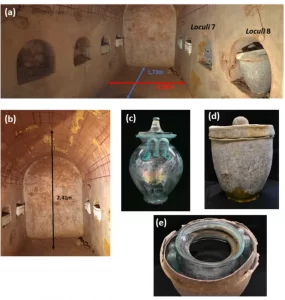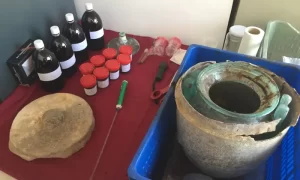In a remarkable find, the oldest liquid wine ever discovered has been unearthed in a Roman urn with cremated remains in southern Spain. This reddish-brown wine, likely full-bodied, underwent chemical changes over 2,000 years. Researchers from the University of Córdoba confirmed it as a sherry-like local wine.
Discovery and Analysis
A family in Carmona, Andalucía, accidentally discovered the sunken tomb in 2019 while renovating their home. Inside, archaeologists found a rare, untouched Roman tomb with eight burial niches. Six niches contained urns made of limestone, sandstone, glass, and lead, each holding cremated bones. Two urns bore the names Hispanae and Senicio.

José Rafael Ruiz Arrebola, an organic chemist at the University of Córdoba, led the analysis. He praised the homeowners for promptly notifying local archaeologists, who recognized the tomb’s significance due to its undisturbed state. This allowed the preservation of remarkable artifacts, including the liquid wine.
The Wine’s Characteristics

The urn with the wine also contained the cremated bones of a Roman man and a gold ring with a two-headed Janus, likely placed after cremation. Upon finding the liquid, researchers determined it wasn’t from condensation or flooding. They discovered that the five liters of liquid had a pH of 7.5 and contained chemical elements similar to modern wines.
The team identified seven polyphenols exclusive to wine, confirming the liquid’s identity. The absence of syringic acid, a decomposition product of red wine pigment, indicated it was white wine. Local Roman mosaics depicting the trampling of white grapes supported this conclusion.
Similarity to Modern Wines
Ruiz Arrebola noted the wine resembled modern wines from Andalucía, such as Montilla-Moriles, sherry from Jerez, and manzanilla from Sanlúcar. The research techniques developed during this study could aid future investigations of ancient food and drink.
Although the wine was microbiologically safe, Ruiz Arrebola expressed reservations about tasting it due to its contact with cremated remains. The liquid’s murkiness, influenced by the bone fragments, further deterred him. However, he humorously suggested someone else might try it first.
This extraordinary discovery not only adds to our understanding of ancient Roman customs but also showcases the enduring nature of wine.
















